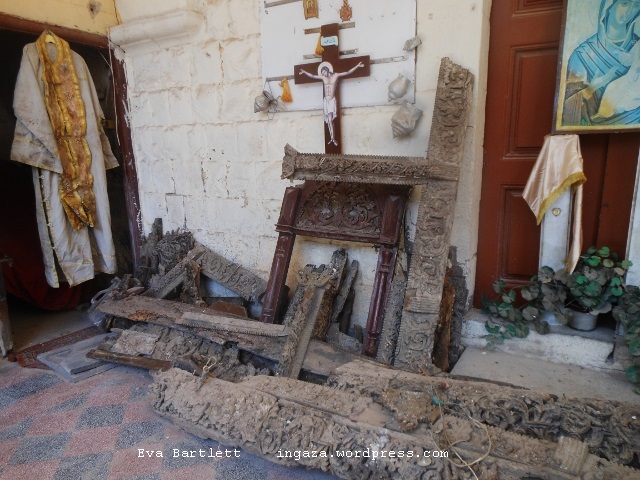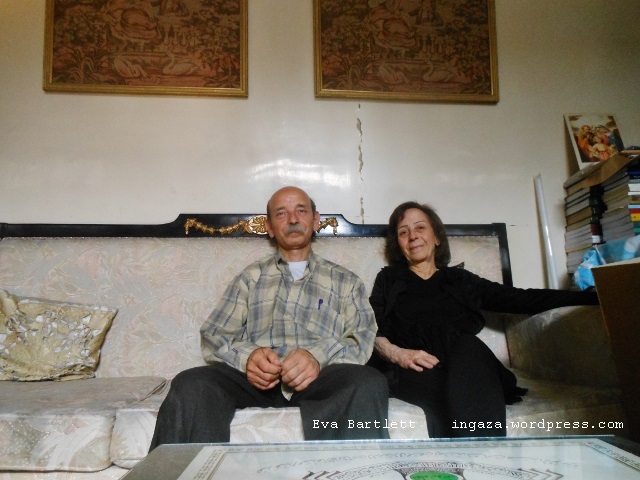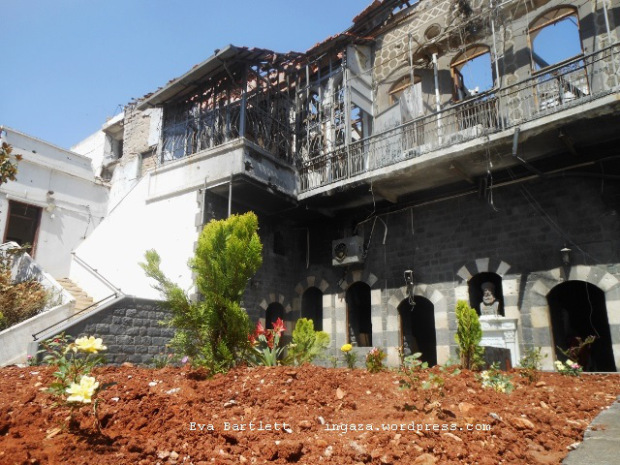This is the final week for our supporter drive and we need your help! Please help rabble.ca continue to amplify voices that offer alternatives to mainstream takes on global politics. Become a monthly supporter.
Al-Waer, Homs’s most populated area and the city’s last insurgent holdout, might soon achieve the truce that Hom’s Old City saw in May this year when, in an exchange deal, the insurgents left their strongholds.
Today, Al-Waer’s population stands at more than 200,000, many of them internally displaced persons (IDPs) who fled their homes in other parts of Syria, only to find themselves caught in the middle of the efforts of the Syrian army to eradicate the armed militants.
Homs, Syria’s third-largest city and dubbed in the media as the “capital of the revolution,” suffered nearly three years of the insurgents’ presence and the Syrian army’s fight to oust them and restore calm. By May this year, many areas had been destroyed by both army bombing and insurgent rockets and car bombs.
On May 9, 2014, Homs’ Governor Talal Barazi was reported as having declared Homs “empty of guns and fighters” and under a truce agreement, the roughly 1,200 insurgents who had taken over most of the Old City in early 2012 were bussed out and residents could finally return to their neighbourhoods.
Some of those residents who had stayed on in the Old City of Homs during the siege talked to IPS about their ordeals and losses at the hands of armed groups, including Nusra and Farooq brigades. Many of them argued that what had happened in Homs was not revolution, as Dutch Jesuit priest Frans van der Lugt had argued before he was assassinated, just one month before Homs was liberated.

“I was baptised in this church, got married in it, and baptised my children in it,” said Abu Nabeel, a resident of Homs’ Old City. The St. George Church, with its crumbling walls, is one of 11 reported destroyed in the Old City. It no longer has its wooden ceiling and ornately-carved wooden ceiling panels and wall lattice lie in heaps outside the ancient church.
“Most of the damage is from the last days just before the insurgents left,” he said. “But we’ll rebuild.”That rebuilding has already begun, with residents scraping away rubble and re-paving small areas that had been damaged.
The arched interior of the St. Mary’s Church (Um al-Zinnar) bears the char marks of its burning by retreating insurgents. Like many others, the church was looted of objects and vandalised, with the insurgents leaving sectarian graffiti on the walls. “Symbols related to Christianity were removed. Even from inside houses. If you had a picture of the Virgin Mary, they removed it,” said Abu Nabeel.
Volunteers have now planted a garden in its courtyard, which they say is an attempt to “bring some beauty back” to Homs.
A statue in the courtyard of the Church of the 40 Martyrs stood headless. “This was one of the founding fathers of the church, so they cut the head off the statue,” said Abu Nabeel.
The church itself was less damaged than others, but Abu Nabeel noted that “they burned the pews, for heat.”
Outside the door of an old but intact building, a few men hosed down the street and repaved small sections of the walk.
“This was one of the biggest restaurants in the Old City of Homs. People used to hold weddings here,” Abu N said of the building. “It was used as a headquarters for the insurgents. There was some damage inside, but they have already fixed a lot of it.”
Youth volunteers on a street in Bustan al-Diwan painted over the insurgents’ graffitti and used shattered glass from the Church of Saida Salaam to create a colourful mosaic.
Rubble which littered the streets had been swept into heaps in the centre of some lanes, allowing people to pass.
A man brushed rubble off the second story ledge of his building, one of few people around in the Old City in spite of the calm.

Nazim Kanawati, who knew and respected the Jesuit, arrived moments after the 75-year-old priest had been shot in the back of the head.” We were surrounded and under siege. This was the only place we could go to. Everyone loved it here,” he said.
“Father Frans was a peace-maker and played an important role in arranging the evacuation of civilians from the Old City during the siege. He was trusted by both sides, and didn’t distinguish between Christians and Muslims. He was concerned with humanity.”
Like Father Frans, Kanawati refused to leave Homs while others fled. “I didn’t want to leave, I’m a Syrian, I had the right to be there.”
Although he chose to stay in the Old City, Father Frans was critical of the insurgents. In January 2012, he had written: “From the start I saw armed demonstrators marching along in the protests, who began to shoot at the police first. Very often the violence of the security forces has been a reaction to the brutal violence of the armed rebels.”
“People in Homs were already armed and prepared before the protests began,” said Kanawati. “If they hadn’t been planning for the protests from the beginning, the people wouldn’t have had the quantity of arms that they had.”
Abu Nabeel explained that in addition to the Hamidiyeh district where various old churches are to be found, Christians in other areas occupied by the armed insurgents also fled. “There were an estimated 100,000 Christians living in the Old City of Homs before it was taken over by terrorists. Most fled in February 2012. By March, only 800 had stayed, and by the end just over 100 remained,” he said.
The siege that the Syrian army enforced on the Old City in an attempt to drive out the insurgents had a drastic effect on the daily lives of those remaining.
“Suddenly, we didn’t have electricity or water. We had to wait for the water trucks to refill tanks,” said Kanawati. “There were many elderly who couldn’t leave their homes. We’d take food and medicine to people in the community.”
Before Homs was freed of the armed insurgents, who were also stealing from homes, life had become impossible. “There was food at the beginning, but it started to run out. At the end we had nothing, we ate whatever we could collect,” said Kanawati.
No one expected the priest himself to be killed, Kanawati attested. “Someone who was probably in his twenties came here, his face covered, came and ordered Father Frans to go with him. Father Frans refused. So the man told him to sit on this chair, and shot him in the head.”

Abu Nabeel added another piece of information regarding van der Lugt’s murder.
“Three or four days before Father Frans was killed, the Syrian army had targeted a vehicle filled with explosives, which the insurgents were planning to send into the city. Many of the insurgent leaders killed were less extreme that the foreign insurgents, and had been protecting the church. After their deaths, the other insurgents went to the church and demanded Father Frans hand over the valuables residents in the area had left with him for safe-keeping. He refused, so they killed him.”
Mohammed, a Syrian from the Qussoor district of Homs, is now one of the reported 6.5 million internally-displaced Syrians.
“I’m a refugee in Latakia now. I work in Homs, two days a week, and then return to Latakia to stay at my friend’s home. I left my house at the very end of 2011, before the area was taken over by al-Nusra and al-Farooq brigades.”
He spoke of the sectarian nature of the insurgents and protests from the very beginning in 2011.
“I was renting a home in a different neighbourhood of Homs, while renovating my own house. Just beyond my balcony there were protests that did not call for ‘freedom’ or even overthrowing the ‘regime’.They chanted sectarian mottos, they said they would fill al-Zahara — an Alawi neighbourhood — ith blood. And also al-Nezha – where there are many Alawis and Christians.”
“My aunt lives in another neighbourhood nearby. She’s Allawi and her husband is Sunni. Because she is Allawi, the ‘rebels’ wanted to kill her two sons. I chose Bashar al-Assad, so they said, ‘we will kill you, because you chose him.'”
The windows and door handle to the home of Aymen and Zeinat al-Akhras were missing, but the house itself was intact. Zeinat, a pharmacist, and Aymen, a chemical engineer, survived the presence of the armed men and the resulting siege on the Old City.
Every space in their small sitting was filled with the books and boxes fleeing family and neighbours, entrusted to the Akhras siblings who chose to weather the storm.
“We didn’t leave, we chose not to.” said Zeinat.
“Our family shop is about 75 years old now,” Aymen added. “We didn’t want to lose it or the merchandise.” Much of it he brought to the home, moving from shop through a hole in the wall to the back yard, so the insurgents wouldn’t see and steal the goods.
The area was taken over in two stages, they explained. “First, the insurgents reached near our house, while the Syrian army was on the other side. Fifteen days later, the insurgents brought more forces and arms and took over the area, killing all of the Syrian soldiers in that area. In February, 2012, they took over the Old City completely,” Aymen said.
Zeinat spoke of the power cuts, which sometimes lasted give days, and the lack of cooking gas.
“We started using the wood stove. We’d put the pot on at 10 am, eat at 4 pm… It didn’t matter that we didn’t have electricity for the fridge—we had no food to put in it,” she said.
“I’ve gained five kilos!” Zeinat said. “I dropped to 34 kilos. Aymen told me to weigh myself. I got on the scale and said, ‘What’s 34 kilos?’. A ten-year-old weighs more than that! And Aymen was 43 kilos. For a man, 43 kilos,” she said laughing.

The drastic drop was not due to ill-preparedness. To the contrary, Zeinat said they had enough food to last a year.
“We were twelve siblings with eight houses in the area, and the family house. We all had stores of food.”
But the stores of food didn’t survive the looting of the insurgents.
“Thirty-eight times they came to steal our food. The first couple of times, they knocked on the door, after that they just entered with guns. The last things they took were our dried peas, our cracked wheat, our olives, finally our za’atar (wild thyme). We started to eat grass and whatever greens we could find in February, 2014, and that’s all we had till Homs was liberated,” Zeinat said.
“The last time they came all we had were some spices. I was putting the spices on the grass and weeds that we were eating at that point, to give them some flavour. They even took the spices. They didn’t leave us anything.”
The insurgents also stole valuables. “Money, gold, and they took my passport,” Zeinat laughed. “What do they want with it?”
Abu Abdu had a home in a district of Homs between Khaldia and Bayada
“I was never interested in politics, I’d always change the channel if it was news. But when the events started here, and we began to see the lies, my sense of nationality awoke and I began to look at the news all the time,” he said.
Showing video and photos of his area, he explained, “This is our apartment building, we were on the third floor. I took this footage around May 10, after the insurgents left Old Homs.”
“Took our personal belongings, our money, they stole everything, even the pumps used to pump water up to the higher floors. They stole the electrical wiring, the electricity meters, the taps in the kitchen and bathroom, the engine of the washing machine…they couldn’t take the whole machine so they took the engine. They took the ceiling fan, the wall tiles….They broke my daughter’s wooden jewelry box to get the 100 Liras in it of different Syrian coins her fiance had given her as a gift. All that effort for 100 Syrian pounds (about $1.50),” he said.
Meanwhile, despite the return of calm to Homs’ Old City, insurgents continue their campaign of car-bombing civilian areas of Homs. Tens were killed by car bombs and rocket attacks in June alone.
On June 19, Sana news reported six killed and forty injured in a car bombing, as well as seven killed, 25 injured six days prior.
The Syrian government, however, continues efforts to restore normality to the city. On June 26,Sana news reported that the Minister of Culture, Lubanah Mshaweh, said plans were underway for the restoration of Homs’ Khalid Ibin al-Walid Mosque, St. Mary (Um al-Zinnar) and 40 Martyrs churches.
Also on June 26, the Nusra brigades, an al-Qaeda affiliate and one of the main factions which occupied Homs, is reported to have pledged allegiance to the Takfiri extremist Islamic State in Iraq and Syria (ISIS).
This allegiance to a group documented to have beheaded, mutilated, crucified and flogged Syrians and Iraqis gives more credence to Homs’ residents’ opinion that the events in Syria are no revolution.
All photos by Eva Bartlett




